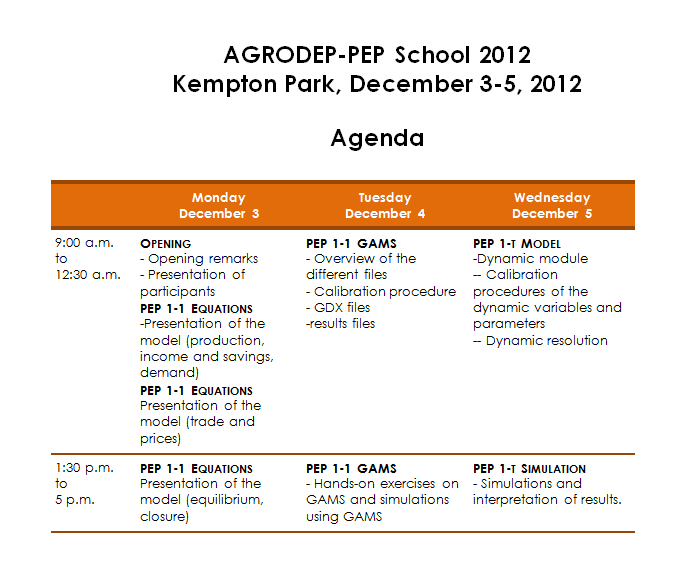GENERAL OVERVIEW
PEP is proud to offer models that are not only fully operational for applied studies but are also perfectly suitable for training. Indeed, the MPIA (Modelling and Policy Impact Analysis) team has made painstaking efforts to produce documentation that is complete, including references to theoretical underpinnings and detailed mathematical developments that link model equations and calibration procedures with the theory.
In the context of PEP’s collaboration with AGRODEP, user guides as well as training material are being developed to further facilitate the appropriation of the methodology and models by local researchers. A three-day workshop on PEP models is envisaged.
Pre-activities before the training course
 Download PEP 1-1 model and PEP 1-t model.
Download PEP 1-1 model and PEP 1-t model.
Training Agenda
Day 1: PEP 1-1 – The overall structure
The PEP-1-1 model (1 country – 1 period) is a static computable general equilibrium (CGE) model designed for the study of a national economy and intended to be an operational tool for PEP Network researchers and other users. With it, researchers will be able to develop a relatively standard model, and easily apply it to their country, whatever the particular structure of their social accounting matrix (SAM).
The first half of the day will be devoted to the mathematical structure and the underlying hypotheses of the model. During the second half, the structure of the SAM will be discussed so that participants understand the national accounting definitions used and become familiarized with the format to be utilized in the GAMS code.
Day 2: PEP 1-1 – Programming and running simulations using GAMS
The first part of the day will allow participants to go through the GAMS code with the trainers. Calibration methods, data handling with GDX, and the coding of the model will be reviewed. Hands-on exercises during the second half of the day will complete the training on PEP 1-1.
Day 3: PEP 1-t
The PEP-1-t (1 country – t periods) model follows the PEP-1-1 single-country, single-period model. It is a recursive dynamic model, the second research tool of the Standard PEP Model project. PEP-1-t takes a step cloesr to deepening of our understanding of CGE analysis and the development modeling techniques that will be used to tackle new problems.
The first part of the day will be spent on the dynamic aspects of PEP 1-t, as all other characteristics of the model are identical to those of PEP 1-1. The rest of the day will be devoted to the calibration, coding, and numerical resolution options. Once again, the training will be composed of theoretical presentations as well as hands-on exercises.
Training materials
- THE PEP STANDARD COMPUTABLE GENERAL EQUILIBRIUM MODEL SINGLE-COUNTRY, STATIC VERSION PEP-1-1
- THE PEP STANDARD COMPUTABLE GENERAL EQUILIBRIUM MODEL SINGLE-COUNTRY, RECURSIVE DYNAMIC VERSION PEP-1-t
- SAM: THE PEP STANDARD COMPUTABLE GENERAL EQUILIBRIUM MODEL SINGLE-COUNTRY, STATIC VERSION PEP-1-1
INSTRUCTOR
Helene Maisonnave has a
Online Application
 Click here to apply this training course. Applications are welcome until October 31, 2012.
Click here to apply this training course. Applications are welcome until October 31, 2012.
